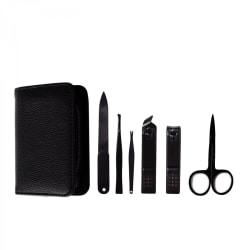Ingrown Toenails
– Men’s Grooming Guide
Ingrown toenail – when the side edges of the nail grow into the skin. This is indeed an extremely painful situation and people with thicker nails are often more susceptible to this predicament. As ingrown toenail constantly breaks the skin, it may also cause bacteria entry and lead to infection. Before we delve deeper into the effective ways to deal with this problem, let’s take a quick look at:

the causes of ingrown toenails:
- Ill-fitted shoes that are too tight, narrow, or flat and result in a lot of pressure
- Cutting the toenails inaccurately may cause the nails to grow into the skin
- Inadequate foot hygiene such as not keeping the feet dry or clean
- Vascular problems or numbness in the toes
- Hereditary problems
- Injury in toenails
Symptoms of Ingrown Toenails:
- Slight fluid buildup around the toenails
- Red, swollen and painful skin around the nails
- Formation of puss around the toenails (in case of bacterial infection)
- Bleeding (in case of bacterial infection)
- Painful sensation, especially, when pressure is exerted on the toe
Proven Ways to Prevent Ingrown Toenails
- Clip the Toenails with Caution: Clipping the nails with caution holds the key to preventing ingrown toenails. Cutting the nails unevenly at the corners may worsen the problem. Also, make note that snipping the nails too short is one of the most common reasons behind the formation of painful toenails.
- Wear Comfortable Socks and Shoes: When your socks and shoes do not give you comfortable space in the toe bed, it can lead to the growth of ingrown toenails. Also, be mindful that non-breathable synthetic socks make the toes sweaty and increase the chances of infection.
- Take Adequate Care of Your Feet: In order to prevent ingrown toenails, soak your feet and trim the nails before gently cleaning them with a cotton swab.
Tips
If your ingrown toenails are infected, make a small cotton ball, almost about the size of a match head. Dip it in a drying alcohol solution, which is readily available in pharmacies and insert it into your toenails with tweezers. This process may be painful at first but this bacterial cure works effectively.
If your ingrown toenail is a persisting problem, do not ignore it. Rather, when your toenails are painful, red and swollen, it is always advisable to seek professional help. For recurring ingrown nails or prolonged infection, your physician may suggest a permanent solution. So, don’t fret and go for it!

